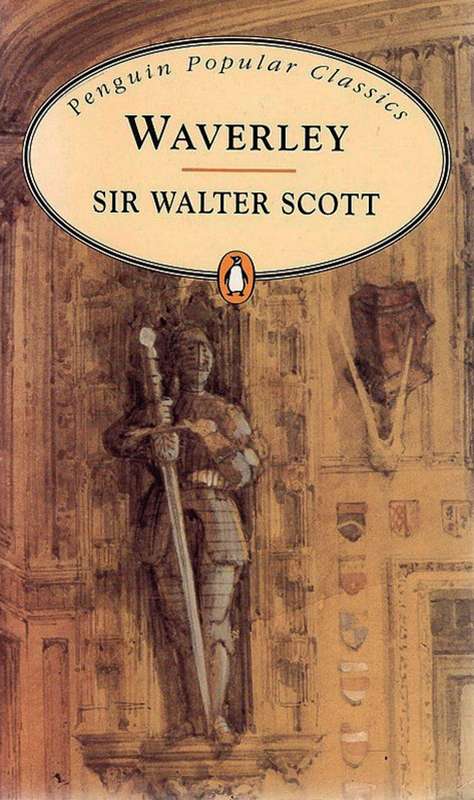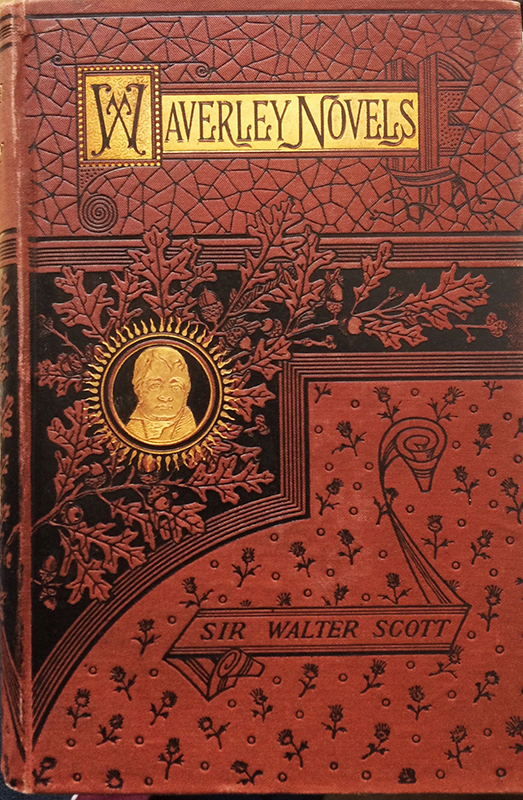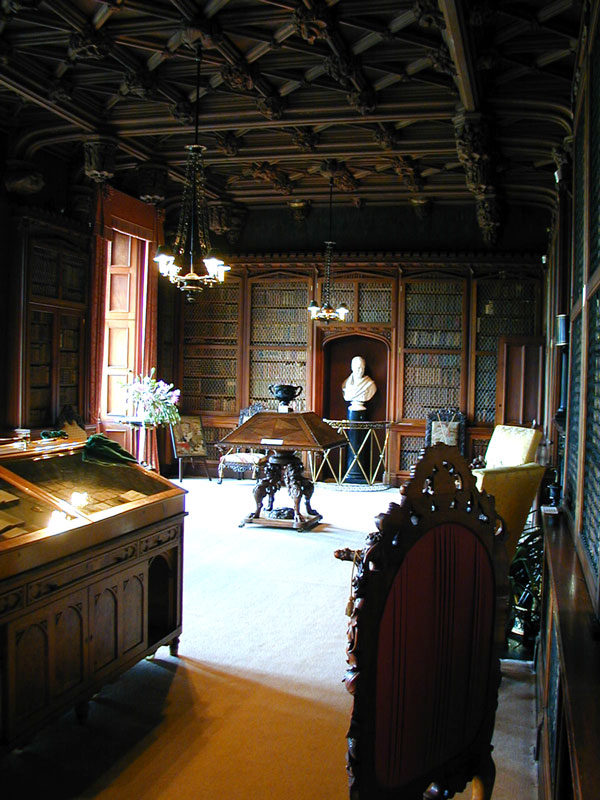On April 16th 2021, I decided (at last) to fulfill the promise we had made, Janice and I, to Sir Walter Scott a few years ago. Our promise had been made during one of our unforgettable visits at Abbotsford, the writer’s beloved home in the Scottish Borders and it was nothing less than to read all Sir Walter’s books! I’m not sure we realized then what a big challenge it would be. Just have a look at the wikipedia article devoted to Sir Walter Scott to see the number of books he wrote including novels, short stories, poetry, essays…
This reading challenge can be a good way to celebrate the 250th anniversary of Sir Walter Scott. Let us remember that the author was born in the Old Town of Edinburgh on 15 August 1771.

Walter Scott at his desk in his Abbotsford study © 2006 Scotiana
We’ve spent unforgettable moments at Abbotsford, always feeling as if the Master of the place was still there? In every room as well as in the lovely grounds extending around the house and along the Tweed… we do love the place and the books Sir Walter wrote there. We could stay hours in his library filled with thousands of old volumes, looking at the titles and it is extremely moving to stand in front of the desk where Sir Walter spent so many hours, working himself to death, like Balzac, to pay his debts, or at least the debts for which he felt responsible.
We’ve already read a number of Sir Walter’s books and among them novels (Quentin Durward – Rob Roy – The Fair Maid of Perth), Sir Walter’s Journal and also short stories (‘The Highland Widow’ … ‘ My Aunt Margaret’s Mirror’ … ‘ The Tapestried Chamber’)
Though it’s becoming more and more difficult for me to find reading time , I’ve decided to read a minimum of one or two chapters of Waverley per day. I can’t do more for at the end of June we’re moving to our new house in Dordogne. So far I’ve reached chapter LIII in roman numerals (53).
Our future home is situated in a lovely place of Dordogne, in the heart of Périgord Noir not far from Sarlat and the famous castles of Castelnaud and Beynac. A place much loved by British people and especially by Scottish people. Indeed, the present owners of the house are Scottish! The land around the house is more than one hectare and, while walking down there, I’ve discovered a number of thistles 😉

Beynac Castle Dordogne France © 2010 Scotiana
The date of April 16th 2021 to begin my reading of Walter Scott’s books was not chosen by chance. As remembered by Iain and Margaret there are three dates on the Scottish calendar not to be missed in 2021
- 250th birth anniversary of Sir Walter Scott (15 august 1771)
- 275th anniversary of the battle of Culloden (16 April 1746)
- 100th birth anniversary of George Mackay Brown (17 October 1921)
I would like to add to these anniversaries the bicentenary of the death of Napoleon on St Helena Island on 5 May 1821. Sir Walter Scott wrote a biography of the French emperor (1827).

Waverley by Sir Walter Scott Penguin Popular Classics
I chose to begin my reading with Waverley. First because it is the first novel of the Waverley novels and also because the theme of the book is the last Jacobite rising which ended (or not) on Culloden moor on that fateful day of 16 April 1746, 275 years ago.
Date of composition and subject of Waverley
Evidence about the composition of the first volume of Waverley is inconclusive, but it was probably begun in 1808 and laid aside, continued in 1810 and again laid aside, and eventually taken up and completed in the later part of 1813. The second and third volumes were written in the spring and early summer of 1814. Scott had an intimate acquaintance with Jacobite history, and Waverley draws on an extensive range of anecdotal and historical literary material. He had talked to people who had been involved in the 1745 uprising, or to those who had known them. He drew on the resources of his extensive library for relevant printed material. (Wikipedia)
From the “General Preface to the Waverley Novels” published in… I got a lot of interesting information about Waverley, the first volume of the “Waverley Novels”.
My early recollections of the Highland scenery and customs made so favourable an impression in the poem called The Lady of the Lake, that I was induced to think of attempting something of the same kind in prose. I had been a good deal in the Highlands at a time when they were much less accessible and much less visited than they have been of late years, and was acquainted with many of the old warriors of 1745, who were, like most veterans, easily induced to fight their battles over again for the benefit of a willing listener like myself. (…)
(…) It was with some idea of this kind that, about the year 1805, I threw together about one-third part of the first volume of Waverley. It was advertised to be published by the late Mr. John Ballantyne, bookseller in Edinburgh, under the name of Waverley; or, ‘Tis Fifty Years Since—a title afterwards altered to ‘Tis Sixty Years Since, that the actual date of publication might be made to correspond with the period in which the scene was laid. Having proceeded as far, I think, as the seventh chapter, I showed my work to a critical friend, whose opinion was unfavourable; and having then some poetical reputation, I was unwilling to risk the loss of it by attempting a new style of composition. (…) the specimen subjected to his criticism did not extend beyond the departure of the hero for Scotland, and consequently had not entered upon the part of the story which was finally found most interesting.
Be that as it may, this portion of the manuscript was laid aside in the drawers of an old writing-desk, which, on my first coming to reside at Abbotsford in 1811, was placed in a lumber garret and entirely forgotten. Thus, though I sometimes, among other literary avocations, turned my thoughts to the continuation of the romance which I had commenced, yet, as I could not find what I had already written, after searching such repositories as were within my reach, and was too indolent to attempt to write it anew from memory, I as often laid aside all thoughts of that nature.
My thoughts, therefore, returned more than once to the tale which I had actually commenced, and accident at length threw the lost sheets in my way.
I happened to want some fishing-tackle for the use of a guest, when it occurred to me to search the old writing-desk already mentioned, in which I used to keep articles of that nature.
I got access to it with some difficulty; and, in looking for lines and flies, the long-lost manuscript presented itself.
I immediately set to work to complete it according to my original purpose.
And here I must frankly confess that the mode in which I conducted the story scarcely deserved the success which the romance afterwards attained.Waverley was published in 1814, and, as the title-page was without the name of the Author, the work was left to win its way in the world without any of the usual recommendations. Its progress was for some time slow; but after the first two or three months its popularity had increased in a degree which must have satisfied the expectations of the Author, had these been far more sanguine than he ever entertained.
Great anxiety was expressed to learn the name of the Author, but on this no authentic information could be attained. My original motive for publishing the work anonymously was the consciousness that it was an experiment on the public taste which might very probably fail, and therefore there was no occasion to take on myself the personal risk of discomfiture. For this purpose considerable precautions were used to preserve secrecy.

The Waverley Novels by Sir Walter Scott – ancient volume
Publication Order of Waverley Novels Books :
- Waverley (1814)
- Guy Mannering (1815)
- The Antiquary (1816)
- Rob Roy (1817)
- Ivanhoe (1819)
- The Monastery (1820)
- The Abbot (1820)
- Kenilworth (1821)
- The Pirate (1822)
- The Fortunes of Nigel (1822)
- Peveril of the Peak (1822)
- Quentin Durward (1823)
- Saint Ronan’s Well (1823)
- Redgauntlet (1824)
- Woodstock (1826)
- Anne of Geierstein (1829)

Smailholme Tower Sir Walter Scott 250th anniversary Phil Wiklkinson source BBC
https://www.bbc.com/news/uk-scotland-south-scotland-56455990
Since we won’t go to Scotland in 2021 this reading challenge will be my personal way of celebrating the 250th anniversary of Sir Walter.
Indeed many celebrations are taking place everywhere in Scotland (Smailholm Tower – Abbotsford…)

Scott’s View – The Eildon Hills in the Scottish Borders © 2019 Scotiana
Places related to Sir Walter Scott in Scotland.
In our next posts, we’ll share with you our pictures and memories of most of these places.
- Abbotsford
- Smailholm Tower
- Sir Walter Scott’s Courtroom in Selkirk
- Scott’s View
- Dryburgh Abbey
- Edinburgh Castle
- The Scott Monument
- The Writers Museum and Makars Court Edinburgh
- Waverley Station
- Abbotsford
- Smailholm Tower
- Sir Walter Scott’s Courtroom in Selkirk
- Scott’s View
- Dryburgh Abbey
- Edinburgh Castle
- The Scott Monument
- The Writers Museum and Makars Court Edinburgh
- Waverley Station
- Loch Katrine
- Rob Roy country
- Crichton Castle
- Tantallon Castle
- Rosslyn Chapel
- Clyde Falls
- Doune Castle
- Perth
- The Island of Skye
- Staffa island and Fingal Cave
- Orkney & Shetland islands

Abbotsford “A Museum to live in” © 2001 Scotiana
Sir Walter Scott called his home ‘a museum for living in’ …

Abbotsford The Entrance Hall Scotiana.com 2001
A museum… but also a library… a fantastic library! It contains more than 4,000 volumes in English, French, German, Latin, Greek…

Library Room – Abbotsford
It’s here, in front of Sir Walter Scott’s statue and amidst so many ancient volumes, that Janice and I made our promise to Sir Walter.

Abbotsford Sir Walter Scott’s study © 2001 Scotiana
Here’s Sir Walter’s study which opens onto the library! The room also contains many books but most of all the author’s desk. Let us try to imagine the author writing, writing all day long, day after day… se tuant à la tâche to pay his debts. It’s such a moving place!

On the Abbotsford page I read : “Scott was an obsessive collector of books, artefacts, weaponry and more, much of which can still be seen in the Abbotsford Collections. But his home was his most cherished possession, ‘the Delilah of his imagination’, his ‘Conundrum Castle’ and ‘flibbertigibbet of a house’ that would ‘suit none but an antiquary.’ Its architecture and interior design made it an iconic building of the 19th century Scottish Baronial style, and it remains a key site in the history of European Romanticism.”

On the above postcard you can see the funny logo of “”The Edinburgh Sir Walter Scott Club”. Janice and I were once members of this club but as Janice lives in Quebec and I (Mairiuna) in France it proved to be quite difficult and rather frustrating for us not being able to participate to the many activities of the club. We finally decided, much to our regret, to put an end to our membership.
This post about Sir Walter Scott marks the beginning of a new literary adventure on Scotiana. From now on, and on a regular basis, we’ll share with you our readings, discoveries and pictures related to the great Scottish writer.
A very popular Scottish author
During his life, and after, Sir Walter Scott was a very popular writer all over the world and especially in France. His popularity for his poetry (The Lady of the Lake’) and most of all for his historic novels, has been compared to that of J.K. Rowling’s Harry Potter books today. Among his French admirers we can name Honoré de Balzac (1799-1850), Victor Hugo (1802-1885), Alexandre Dumas (1802-1870), Prosper Mérimée (1803-1870). One of his greatest admirers was certainly Auguste Defauconpret, his French translator who even visited Sir Walter at Abbotsford. I would not fail to mention Henri Suhamy who wrote a fascinating biography of the author in 1993 and also translated several of his books which were published in the prestigious French edition “La Pléiade”.
While reading and re-reading Sir Walter’s books, we look forward to the time when we can go to Scotland again, to Abbotsford and the many places linked to Sir Walter.
I would like to conclude this post with the 100th birth anniversary of George Mackay Brown which will take place on 17 October 2021. George Mackay Brown, together with Iain Crichton Smith, are the two Scottish writers w at the origin of our first journey to Scotland. Last but not least GMB, as we’re used to call George Mackay Brown, is also at the origin of our meeting with Iain & Margaret. On 17 October, I will write a page about the great Orkney Bard.
On a page published by the Orkney Library I read : “In 1814 Sir Walter Scott visited Orkney and ventured up Brinkie’s Brae to meet the mystical Bessie Millie. The story she told him of Gow the pirate inspired his novel The Pirate and Bessie herself became Norna of the Fitful Head in the story. “La boucle est bouclée” as we say in France. Next time, I will write from our new home in Dordogne.
Bonne lecture!
Á bientôt. Mairiuna


Leave a Reply